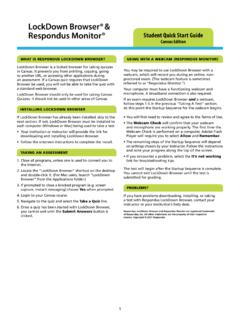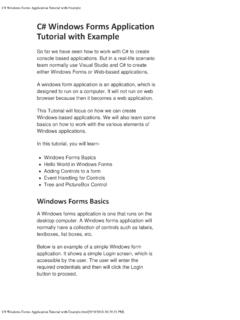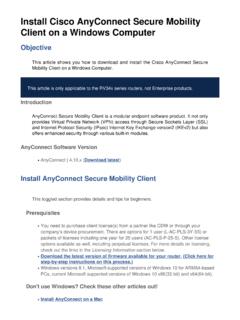Transcription of Case Study on Windows Prof. Sujata Rizal Unit V: Case ...
1 case Study on Windows Prof. Sujata Rizal 1 Unit V: case Study on Windows 1. What is Windows Operating System? Windows OS, computer operating system (OS) developed by Microsoft Corporation to run personal computers (PCs). Featuring the first graphical user interface (GUI) for IBM-compatible PCs, the Windows OS soon dominated the PC market. Approximately 90 percent of PCs run some version of Windows . The first version of Windows , released in 1985, was simply a GUI offered as an extension of Microsoft s existing disk operating system, or MS-DOS. Based in part on licensed concepts that Apple Inc. had used for its Macintosh System Software, Windows for the first time allowed DOS users to visually navigate a virtual desktop, opening graphical Windows displaying the contents of electronic folders and files with the click of a mouse button, rather than typing commands and directory paths at a text prompt.
2 Subsequent versions introduced greater functionality, including native Windows File Manager, Program Manager, and Print Manager programs, and a more dynamic interface. Microsoft also developed specialized Windows packages, including the networkable Windows for Workgroups and the high-powered Windows NT, aimed at businesses. The 1995 consumer release Windows 95 fully integrated Windows and DOS and offered built-in Internet support, including the World Wide Web browser Internet Explorer. With the 2001 release of Windows XP, Microsoft united its various Windows packages under a single banner, offering multiple editions for consumers, businesses, multimedia developers, and others. Windows XP abandoned the long-used Windows 95 kernel (core software code) for a more powerful code base and offered a more practical interface and improved application and memory management.
3 The highly successful XP standard was succeeded in late 2006 by Windows Vista, which experienced a troubled rollout and met with considerable marketplace resistance, quickly acquiring a reputation for being a large, slow, and resource-consuming system. Responding to Vista s disappointing adoption rate, Microsoft developed Windows 7, an OS whose interface was similar to that of Vista but was met with enthusiasm for its noticeable speed improvement and its modest system requirements. History of Windows : Microsoft s Windows operating system was first introduced in 1985. case Study on Windows Prof. Sujata Rizal 2 Windows 1 This is where it all started for Windows . The original Windows 1 was released in November 1985 and was Microsoft s first true attempt at a graphical user interface in 16-bit. Development was spearheaded by Microsoft founder Bill Gates and ran on top of MS-DOS, which relied on command-line input.
4 Windows 2 Two years after the release of Windows 1, Microsoft s Windows 2 replaced it in December 1987. The big innovation for Windows 2 was that Windows could overlap each other, and it also introduced the ability to minimise or maximise Windows instead of iconising or zooming . The control panel, where various system settings and configuration options were collected together in one place, was introduced in Windows 2 and survives to this day. Microsoft Word and Excel also made their first appearances running on Windows case Study on Windows Prof. Sujata Rizal 3 Windows 3 The first Windows that required a hard drive launched in 1990. Windows 3 was the first version to see more widespread success and be considered a challenger to Apple s Macintosh and the Commodore Amiga graphical user interfaces, coming pre-installed on computers from PC-compatible manufacturers including Zenith Data Systems.
5 Windows 3 introduced the ability to run MS-DOS programmes in Windows , which brought multitasking to legacy programmes, and supported 256 colors bringing a more modern, colorful look to the interface. Windows Windows released in 1992 is notable because it introduced TrueType fonts making Windows a viable publishing platform for the first time. case Study on Windows Prof. Sujata Rizal 4 Minesweeper also made its first appearance. Windows required 1MB of RAM to run and allowed supported MS-DOS programs to be controlled with a mouse for the first time. Windows was also the first Windows to be distributed on a CD-ROM, although once installed on a hard drive it only took up 10 to 15MB (a CD can typically store up to 700MB). Windows 95 As the name implies, Windows 95 arrived in August 1995 and with it brought the first ever Start button and Start menu.
6 Windows 98 Released in June 1998, Windows 98 built on Windows 95 and brought with it IE 4, Outlook Express, Windows Address Book, Microsoft Chat and NetShow Player, which was replaced by Windows Media Player in Windows 98 Second Edition in 1999. Windows ME Considered a low point in the Windows series by many at least, until they saw Windows Vista Windows Millennium Edition was the last Windows to be based on MS-DOS, and the last in the Windows 9x line. Released in September 2000, it was the consumer-aimed operating system twined with Windows 2000 aimed at the enterprise market. It introduced some important concepts to consumers, including more automated system recovery tools. case Study on Windows Prof. Sujata Rizal 5 Windows 2000 The enterprise twin of ME, Windows 2000 was released in February 2000 and was based on Microsoft s business-orientated system Windows NT and later became the basis for Windows XP.
7 Windows XP Arguably one of the best Windows versions, Windows XP was released in October 2001 and brought Microsoft s enterprise line and consumer line of operating systems under one roof. It was based on Windows NT like Windows 2000, but brought the consumer-friendly elements from Windows ME. The Start menu and task bar got a visual overhaul, bringing the familiar green Start button, blue task bar and vista wallpaper, along with various shadow and other visual effects. Windows Vista Windows XP stayed the course for close to six years before being replaced by Windows Vista in January 2007. Vista updated the look and feel of Windows with more focus on transparent elements, search and security. Its development, under the codename Longhorn , was troubled, with ambitious elements abandoned in order to get it into production.
8 Windows 7 Considered by many as what Windows Vista should have been, Windows 7 was first released in October 2009. It was intended to fix all the problems and criticism faced by Vista, with slight tweaks to its appearance and a concentration on user-friendly features and less dialogue box overload . Windows 8 Released in October 2012, Windows 8 was Microsoft s most radical overhaul of the Windows interface, ditching the Start button and Start menu in favour of a more touch-friendly Start screen. The new tiled interface saw programme icons and live tiles, which displayed at-a-glance information normally associated with widgets , replace the lists of programmes and icons. A desktop was still included, which resembled Windows 7. case Study on Windows Prof. Sujata Rizal 6 Windows A free point release to Windows 8 introduced in October 2013, Windows marked a shift towards yearly software updates from Microsoft and included the first step in Microsoft s U-turn around its new visual interface.
9 Windows 10 Announced on 30 September 2014, Windows 10 has only been released as a test version for keen users to try. The technical preview is very much still a work in progress. Windows 10 represents another step in Microsoft s U-turn, bringing back the Start menu and more balance to traditional desktop computer users. 2. Explain operating system structure with diagram. The design of an operating system architecture traditionally follows the separation of concerns principle. This principle suggests structuring the operating system into relatively independent parts that provide simple individual features, thus keeping the complexity of the design manageable. Besides managing complexity, the structure of the operating system can influence key features such as robustness or efficiency: The operating system posesses various privileges that allow it to access otherwise protected resources such as physical devices or application memory.
10 When these privileges are granted to the individual parts of the operating system that require them, rather than to the operating system as a whole, the potential for both accidental and malicious privileges misuse is reduced. Breaking the operating system into parts can have adverse effect on efficiency because of the overhead associated with communication between the individual parts. This overhead can be exacerbated when coupled with hardware mechanisms used to grant privileges. case Study on Windows Prof. Sujata Rizal 7 1. Simple Structure In MS-DOS, applications may bypass the operating system. Operating systems such as MS-DOS and the original UNIX did not have well-defined structures. There was no CPU Execution Mode (user and kernel), and so errors in applications could cause the whole system to crash.








